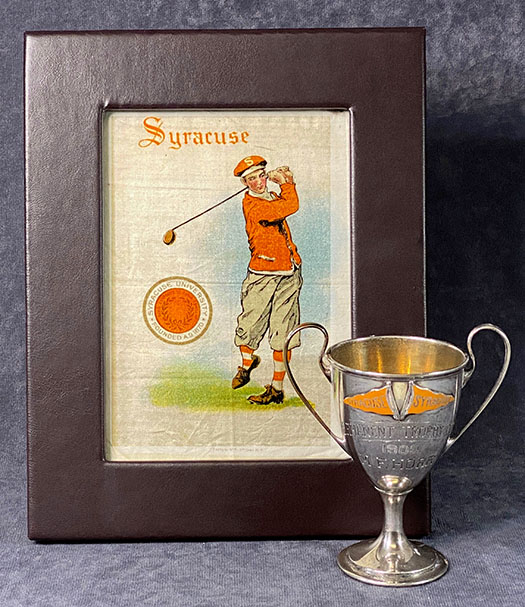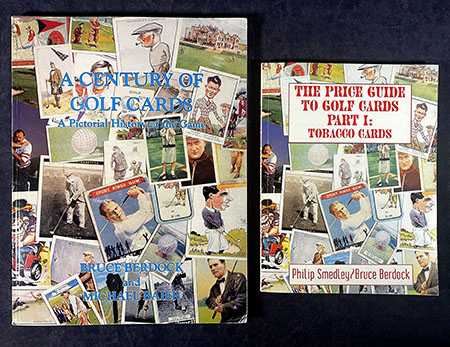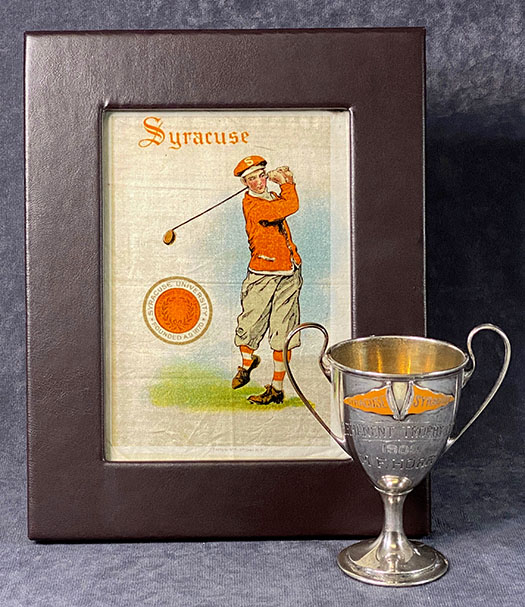
By George Petro
June 2020
Known as a “College Silk” or “Murad Silk”, this particular example features Syracuse University Golf with its official color, orange and its college seal. It was produced in 1910. Not directly associated with the silk is a Syracuse University golf trophy awarded in 1909.
Trade cards (non-tobacco) were known to exist in France in the 1840s and soon elsewhere as a sort of pictorial business card handed out to those purchasing all manner of goods and intended to be saved because of their attractiveness, be they images of historic figures, country scenes or flowers. Some cards evolved into sets or series to promote further product sales.
Cigarettes were packaged with a stiff plain cardboard for protection until an American in the 1870s decided to replace them with those having a variety of images. They were soon dominated by sports themes, hence was the birth of “tobacco cards” worldwide. There was a smattering of golf related images followed by such well-known series as the Cope or Ogden’s tobacco golf series amid others, as well as non-tobacco golf cards.
In 1910, The American Tobacco Company, selling their Murad brand, created the S21 and S22 series which were not paper cards but images on silk. (Other silk editions exist from many sources but are generally devoid of golf content). These two series consist of 250 examples each; 25 different Colleges or Universities depicting one of ten different sports, including golf (thus 25 golf examples). The series were identical except for size. The rarer S21 series measure about 5” X 7” while the S22 are approximately 3 ½” X 5 1/2”. The smaller S22 silks are imprinted with the words MURAD CIGARETTES FACTORY No 7 – 3rd DIST, N.Y. while the S21s omit the words Murad Cigarettes. The schools included, with different figures, colors and seals, are Army, Brown, California, Chicago, Colorado, Columbia, Cornell, Dartmouth, Georgetown, Harvard, Illinois, Michigan, Minnesota, Missouri, Navy, Ohio State, Penn, Princeton, Purdue, Stanford, Syracuse, Texas, Virginia, Wisconsin and Yale.
The ATC produced the B33 series in the early 1900’s known as College “Felts/Flannels” made of 3” X 5” felt with 30 schools in ten sport themes each, but NONE are for golf. Their 1914 T51 College series of paper CARDS included some golf. In 1912 The Imperial Tobacco Company of Canada created a series of 10 colors of “golf silks” with a woven ball above crossed clubs above the word GOLF but are otherwise nonspecific.
A CENTURY OF GOLF CARDS: A Pictorial History of the Game was published in 1993, with a follow-up price guide in 1994, beautifully organizing the numerous issues of Golf Cards in the categories of Cigarette/Tobacco cards, Trade cards, Commercial cards, Magazine insert cards, Package design cards, Panel cards, Premium cards, Silks, PGA Tour cards and other significant examples. Internet searches for information are very productive as well.

The variety and price range of golf cards are vast. The handful of current listings for the more common smaller S22 golf SILKS on eBay are in the $100 range with prices dependent on the school and condition. At the high end of card collecting, that for Bobby Jones in the 1932 U.S. Caramel series in PSA Mint 9 (with none known higher) sold recently for $78,000. For reference, a grade 3 sold for $1,500 in 2017, a grade 4 for $2,250 in 2019, a grade 5 for $4,200 in 2017, and a grade 8 for $19,200 in 2017.

